Sam here: Today’s post is guest written by the pointster, who writes the Canadian Blog www.creditwalk.ca. (Formerly thepointster.ca). Creditwalk.ca is a resource for Canadian credit cards and travel perks. The pointster has graciously offered to outline a solid booking technique here on Milenomics for both American and Canadian Readers, a little something I like to call the Double Down.
—
This is the first article in a 2 part series on combining multiple trips into a single ANA Award ticket.
The first part will focus on the basics of the concept.
The second part will focus on how to fully exploit this and whether it makes sense for you
The Skinny
This 2 part series outlines how to exploit the distance based ANA Award Flights to combine many short trips into a single award redemption, by taking the stopovers ‘at home’. Because ANA award pricing is based on total miles flown for a trip, the flight routings will always matter.
Key Rules of ANA Award Flights:
- Awards must start and end in the same country
- Up to 4 stopovers on any award
- Only one stopover in any given city
Travelers living in cities that have alternate airports close to them (not in the same city) can thus combine multiple trips into a single award ticket.
Washington provides the ideal example, where one could take 1 stopover in “Washington” (IAD or DCA airports interchangeably) and 1 stopover in “Baltimore” (BWI Airport), since all of these airports serve the Washington area well, even though BWI is considered a different city
An example reward ticket could be:
DCA-EWR // EWR-BWI // BWI-ORD // ORD-DCA
For 20K ANA miles and very few taxes / fees.
This can work in many markets in the US, but much tougher to do if your home airport is in Canada due to the distance between airport cities in Canada. Canadians should use alternate US airports (BUF / YYZ or SEA / YVR).
The best cities to exploit this from are:
- Washington DC
- San Francisco
- Philadelphia
- Miami
- Los Angeles
- Chicago
- Boston
- Toronto
- Vancouver
ANA miles can be achieved as follows:
- Amex Membership Rewards USA (1K MR = 1K ANA)
- Starwood Preferred Guest (1k SPG = 1K ANA or 20K SPG = 25K ANA)
Note that ANA miles cannot be achieved by transferring Canadian Amex Membership Rewards.
Introduction
The current ANA award chart is distance based, and has some great rules that will allow us to combine multiple trips into a single itinerary. For people who live in cities where there are multiple nearby airports (not co-terminal airports), it is possible to get two or two and a half round trips for the price of one.
We will exploit these rules for combining many short trips into a single itinerary by taking the stopovers at airports near our home.
ANA is a Star Alliance partner, so this deal would work for redeeming points for flights operated by United, Air Canada and for the first quarter of 2014, US Airways.
Key Characteristics to exploit this deal
The ideal candidate to exploit this deal would have the following:
- Access to two distinct (not co-terminal according to ANA) airports
- Co-terminal airports are those that serve the same city. For example, EWR, LGA and JFK are co-terminal since they all serve “New York”
- Airports that are not co-terminal are those that serve different cities, even if they are close by to each other, such as Washington and Baltimore airports
- The ability to plan and book two future trips as a single itinerary
- Having a Milenomics Demand Schedule will really help you here
- Ideally, some short trips since the rewards are distance based
- Access to enough Star Alliance flights (Air Canada, United or US Airways)
The best cities to exploit this from are:
- Washington DC
- San Francisco
- Philadelphia
- Miami
- Los Angeles
- Chicago
- Boston
Simple Example: DCA-ORD and EWR
The best way to explain this concept is through an example. Let`s say you live in the city of Washington, where you have three nearby airports to choose from when flying:
- Washington Dulles (IAD)
- Ronald Reagan Washington (DCA)
- Baltimore-Washington Thurgood Marshall (BWI)
According to the Star Alliance, and ANA`s rules, IAD and DCA are co-terminal and represent the city of “Washington”, while BWI is a separate airport and represents the city of “Baltimore”.
Let’s say that you know that you have to go to New York in February and then to Chicago in April (Milenomics readers can pick these off a “Demand Schedule”). That means that you will need the following 4 flights:
Using ANA miles, we can do the entire itinerary for only 20K miles, provided we operate within their rules. Here is how: Normally, using miles, this would be considered 2 distinct roundtrips. Using United miles, this would price out at 10K United miles each leg (since they are short hauls) for a total of 40K miles.
Leg 1: Washington to New York
This flight would have to start in any one of the “Washington” airports (DCA or IAD) and fly into any one of the New York airports (LGA, JFK or EWR). We will be calling “Washington” our home.
Leg 2: New York to Baltimore
We would fly any one of New York’s airports and make sure we are flying into “Baltimore” (BWI). We are going to convince ANA that “Baltimore” is just a stopover in our journey.
Leg 3: Baltimore to Chicago
ANA thinks we were visiting Baltimore for the past month. To continue our journey we are going to have to fly out of Baltimore.
Leg 4: Chicago to Washington
We can now go back to a Washington airport. According to ANA, once we come back to “Washington” our journey will end.
By routing this flight so that one of our stopovers is an airport that is easily accessible on the ground, we are essentially able to combine multiple trips into a single itinerary and significantly reduce the mileage costs for the total travel.
In this example, I have put “Washington” on the outside and put Baltimore on the “inside”. We could easily flip it, depending on availability.
The ANA program
The ANA Award Chart
The ANA Award chart is distance based, so you are charged based on the actual miles you fly:
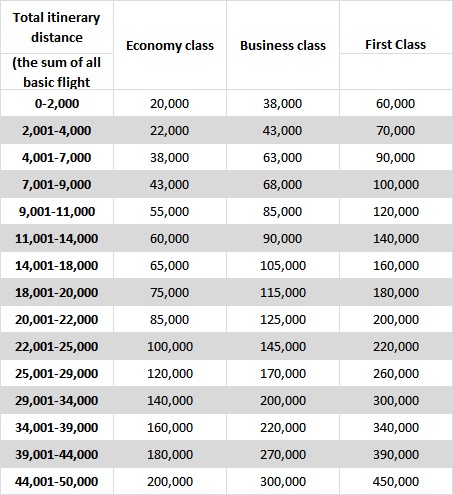
Source: ANA.co.jp
To maximize value, you will want to use the first four distance classes of the reward chart if you are staying within North America. If you are going to be doing two very long roundtrips (coast-to-coast) that push you into the fifth class of the distance chart, you are likely going to be better off buying two distinct roundtrip awards from United / Aeroplan etc, which are priced based on the zone you fly in.
There are four key rules of the ANA program, which enable the ideal itinerary when combined.
Key Rules:
- Up to four stopovers on any award
- Only one stopover in any given city
- Awards must start and end in the same country
- For international itineraries, no stopovers in the country of origin
- For purely domestic itineraries, all 5 stopovers will be in the same country
- “No stopovers or ground transportation within the country of origin are permitted on international routes
- Limit of 12 sectors for each itinerary
Travel is free talks about this here
Deal Potential
If you are based in the US, then you should use this only for flights within the US, while taking your stopover in your home city area. There are many cities in the US where the airport locations cater to this.
If you are based in Canada, then a purely domestic itinerary is much tougher. Most of the airports in Canada are quite far from each other. You are going to have a tough time putting together a purely domestic Canada itinerary that actually makes sense to pursue.
Combining flights in Canada and the US is very achievable, but the cross border rule has to be respected. There are two ways to do this efficiently, depending on where you are based:
1. US Based Flyers
If you are based in the US, you can start your journey in Canada, take your 2 stopovers in your home area, and tack on a flight to Canada on the back end.
- Starting in Vancouver, get back to San Francisco
- Weekend trip to Los Angeles in February
- Return to Vancouver in April
2. Canada based flyers
Within Canada, there aren’t any non co-terminal airports that are easily accessible by public transit on the ground. Therefore, Canadians can only really exploit this for trips to the US, using your “alternate US airport” as the secondary airport. If you are in Toronto, you are going to have to use Buffalo as your second airport and limit your journeys to US destinations.
I discuss how to use these alternate US airports in my Alternate Airport series here.
Example: Toronto based flyer, combining trips to the US
- 2 weeks to Miami area in February
- 1 week trip to Boston in June
Using a regular reward ticket, a Toronto-Miami flight roundtrip would run you 25K Aeroplan miles (or 25K Membership Rewards). In our example, not only are we are getting a free roundtrip to Boston, but we’re also saving 3K Membership Rewards.
Recap
The distance-based nature of the ANA award chart, combined with the liberal stopover rules allow some people to combine multiple trips into a single itinerary for very cheap if some ideal conditions exist:
- Access to multiple Star Alliance served airports that are not co-terminal
- Multiple short trips and a planned demand schedule
The best cities for exploiting the Double Down are Washington DC, San Francisco, Chicago, Philadelphia, Miami, Los Angeles, Boston, Toronto and Vancouver.
Getting ANA miles in North America is best achieved as a transfer partner of American Express Membership Rewards (USA). Canadians who want to take advantage of this deal can transfer miles from Starwood Preferred Guest to ANA.
Check back tomorrow, for the 2nd part in this series, where I’ll focus on how to further exploit this deal and whether it makes sense for you.

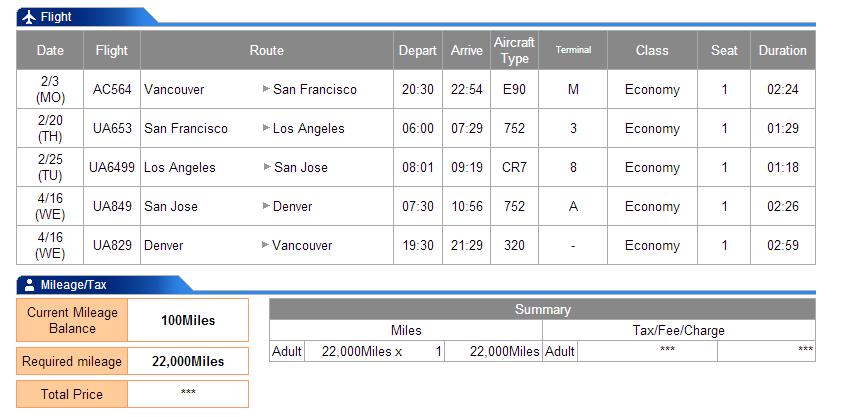

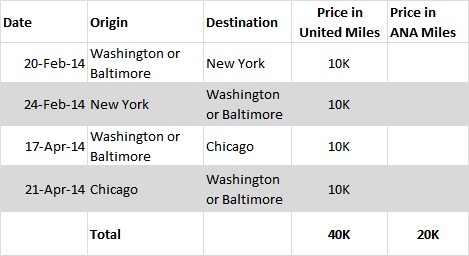
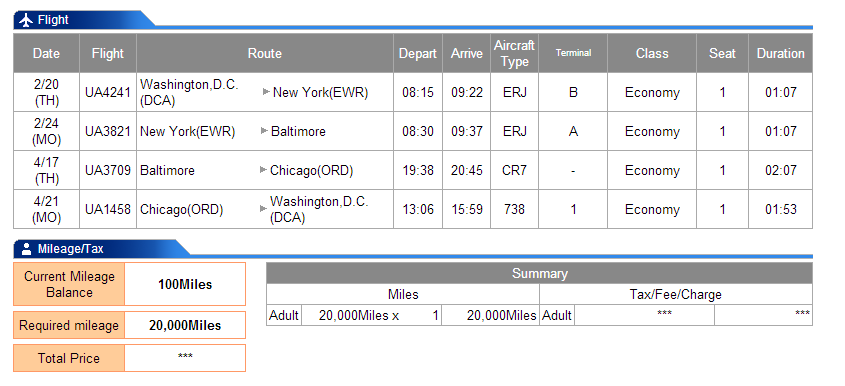
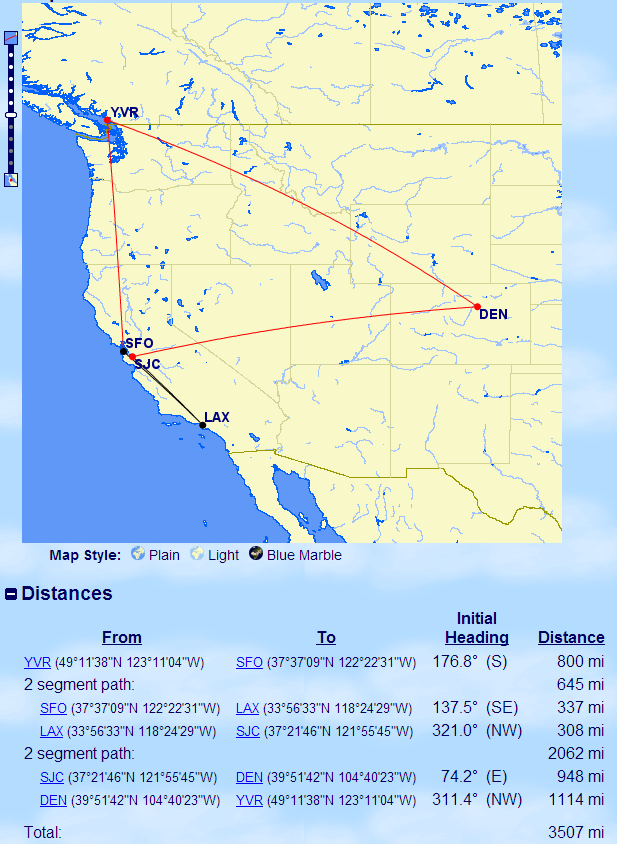

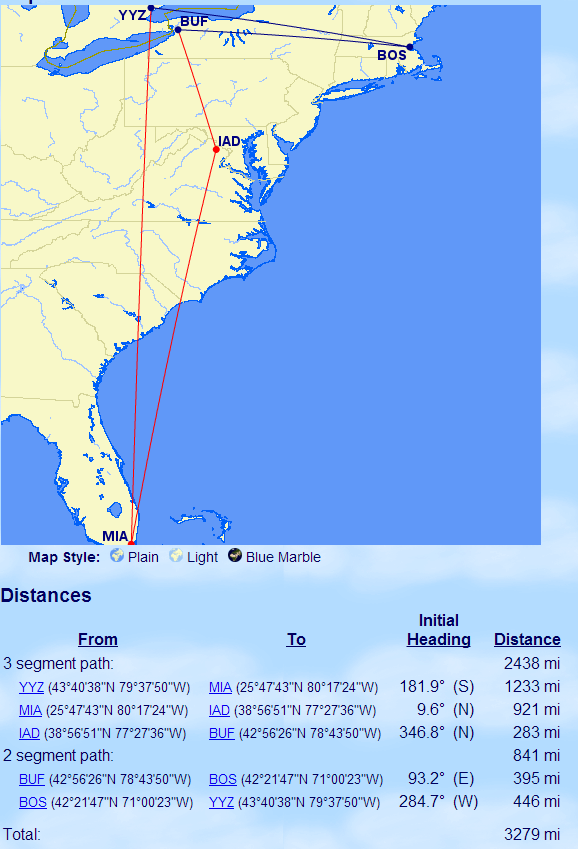
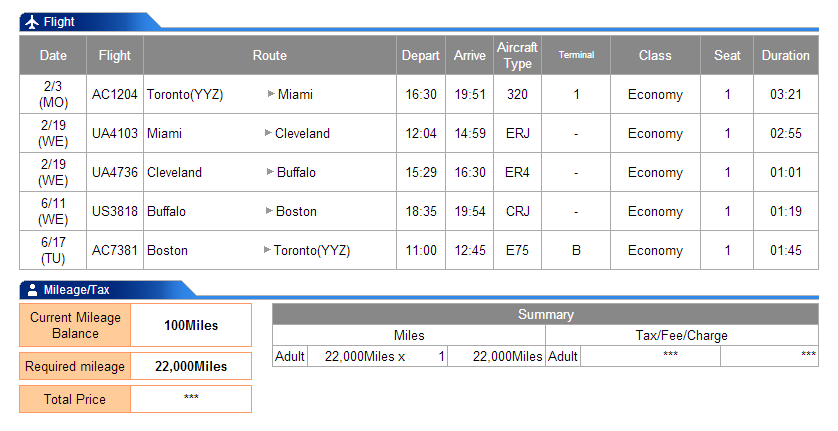

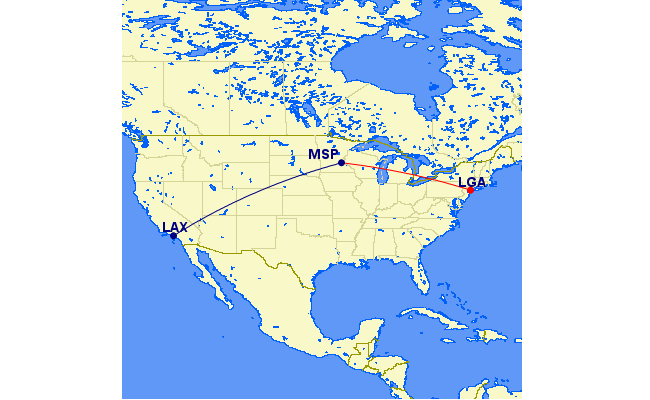
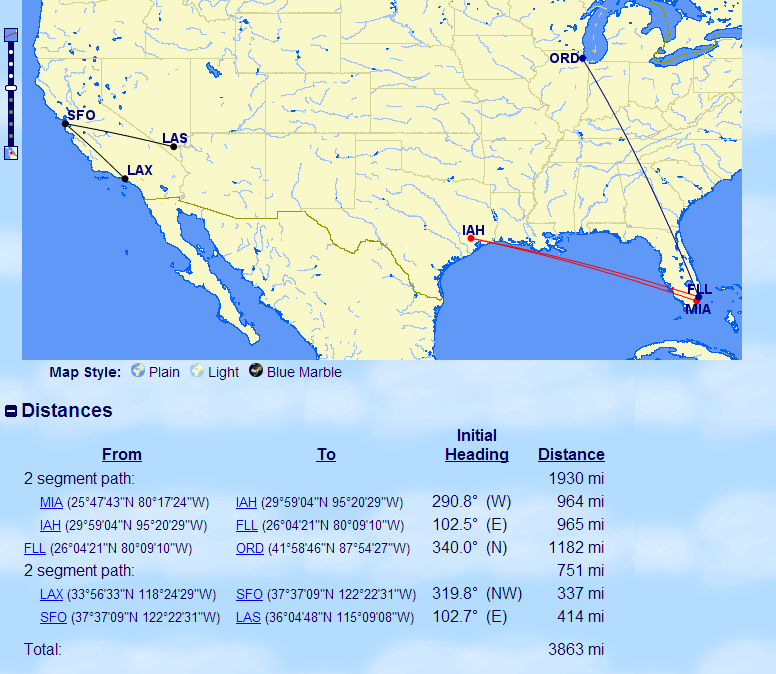
At first look, I was pretty excited by this. (And, in any case, it is very creative!)
But…how much actual saving is there here, say, over using Avios for short haul? And something that appears to have been left out is the mention of 2 one-way shuttles that will be required (e.g., San Jose to SFO). Got to add that to the equation, I think.
Blue: Take any booking technique on a case-by-case basis; no one technique is right all the time. This has a few benefits over avios:
1) No segment by segment pricing. This alone might make it a useful program for you, even without stopovers. 22k ANA for up to 4,000 flown miles would compare favorably even for a simple flight like DAY-ORD-LAX. With Avios you’d have to price DAY-ORD at 4,500 then ORD-LAX at 10,000. The return is then the same, for a total of 29,000 avios vs. just 22,000 ANA miles. And if you had to fly a different routing you’d pay even more in avios but not with ANA miles.
2) If you could alternate flights between two smaller airports like SDF and CVG you could use this technique as well for nested trips, Flying SDF-IAH-CVG, and then CVG-DEN-SDF for the same 22k. This would require 36,000 Avios due to multiple leg flights.
See here: http://first2board.com/milenomics/files/2014/01/SDF-IAH-CVG-DEN-SDF.png
3) Star Alliance–having a good way of booking another alliance can help you out of a jam. When there are no AA or AS flights check UA and US, and use this technique to put together more than one of your upcoming flights into one booking.
4) The transportation issue is a real one–and not to be discounted. For some people this won’t be as big a deal. I know getting to IAD from Washinton D.C. is as much a pain as getting to BWI is. Using those two interchangeably, as long as you didn’t park a car at one or the other, just means a different bus/train ride home. For someone like me, leaving from LAX and returning from BUR means either asking someone to give me a ride to my car at LAX or paying for a shuttle, which could be added expense and inconvenience.
Again not for everyone–but a great way to take advantage of the program, and a really good booking technique the pointster has agreed to write up. Much more on the details and the ways to exploit it tomorrow, so be sure to check back.
Yes, but to complicate matters, you really need to think about how people earn Avios – many do it via Amex MRs which often have transfer bonuses (last year ranged from 20-35%).
I transferred to Avios last year with 35% bonus. So when I go comparing award charts, my easy mental calculation is to deduct 25% Avios from the total to get MR-equivalent miles. So that nominal 9000 Avios r/t from SFO-LAX only cost me ~6,750 MRs vs 20K ANA (= 20K MRs). If I flew SFO-YVR (1600 miles r/t), it would be a nominal 20K Avios = effective 15K MRs due to the 35% bonus. ANA would be 20K.
ANA has a sweet spot in the lower middle award bands where they are better value than Avios even with the 35% bonus. That said, it’s not a very big margin and I suggest the ease of booking with Avios is worth a modest premium over the hassle ANA can offer.
To me, the most obvious advantage with ANA is they are *Alliance and can get you to places that OneWorld/Avios can’t get you nonstop, thus likely saving you miles on Avios’ distance based chart.
Finally, you have to consider the cost of the positioning flights. In the example, how is a SFO based flyer to get to YVR? By magic carpet? That carpet ride needs to be included in the cost somehow.
In the real world, I doubt many people could really take great advantage of ANA’s liberal award rules.
Excellent! Another good airport pair is CVG and DAY, if you live in the northern part of Cincinnati (which is where the majority of Cincinnati is). Because CVG is actually in Northern Kentucky, it’s not a lot further to DAY (maybe 60 minutes compared to 30 with much less traffic)
Am I correct that (like Avios), if it’s not a non-stop flight you have to add up the mileage of each leg? But the advantage comes that you only calculate what reward level you’re in at the end (unlike Avios which calculates each leg on its own)?
PWAC: Good tip about DAY, I know some readers are in the area so that is why I used those cities.
As for the question about connections, pricing for ANA Awards is based on the total flown miles. As you said, you pay based on what you calculate at the end, so there will be times when you’ll want to try to stick to more direct routings to keep things under the limit. When you have “leftover” miles you can do some really fun stuff with them (see tomorrow’s post for more details!).
Are you sure you have a lot of Cincinnati readers? Or do I just visit your blog a lot? 😀
One thing that I didn’t consider until I started looking at real-life possibilities is that Cincinnati and Dayton are close together, yes, but the ground transportation between them is trickier – you’d pretty much need to have someone come and drop you off / pick you up since you leave from one of those airports and come back at the other.
Looking forward to reading Part 2!
LoL, could be both. One issue with DAY was that there aren’t direct flights to IAH, so I would have burned up too many miles connecting to also go to DEN.
Between mileage concerns and the distance between airports there are some real issues to be worked out depending on where you live. You’re right, being dropped off is when this can really works the best. If you live equidistant from 2 airports and are getting a ride then it doesn’t really matter which airport someone drives you to.
PWAC,
Your ability to access that alternate airport is key in this situation.
If you are fortunate to live in a city with good public ground transportation. This is why I mention that Washington DC and San Francisco are the best. As Milenomics mentioned earlier, from Washington DC, getting to BWI is actually easier than IAD, depending on where you are in the city.
If you are in San Francisco, SJC is easily accessible by Caltrain and OAK is accessible by BART.
If you are in New Jersey / Philadelphia, there is good train access to both PHL and EWR on NJ Transit.
… and so on.
Having good access to public transportation is a very key element here. All of the cities I suggest as good candidates have good public transportation to access both the main and alternate airports, which makes them good candidates.
In Part 2 of this article, I’ll link to my listing of suggested alternate airports for your region.
Wow, this is great. Too bad I live in the wrong place to do it!
There are better and more versatile trips available at 4000, 7000 and 9000 miles even if it takes positioning flights to complete the trips. Example: AUS-SJO and AUS-SEA – book AUS-IAH-SJO(stop)-IAH-DFW(stop, Avios to/from AUS)-DEN-SEA(stop)-DEN-AUS. 38K ANA and 9K Avios rather than 60K AA/UA. This could be stretched even further with WN instead of Avios for positioning.
Does ANA Mileage Plan have any close-in award booking fees, like United does?
I don’t think so.
KennyB,
Your routing sounds great, but I think it is going to violate the border rule. Similar to my example in Canada, you must start and end in your home country, even though it is not necessarily the same city.
In your example, I believe you are starting in USA, going to Costa Rica, then coming back to USA for some extra flights.
What you could do, however, is flip it around a bit and do:
SJO-IAH-AUS
AUS-DEN-SEA
SEA-DEN-SAT
SAT-IAH-LIR
for only 6976 miles.
http://www.gcmap.com/mapui?P=SJO-IAH-AUS,+AUS-DEN-SEA,+SEA-DEN-SAT,+SAT-IAH-LIR
The problem with this is that you get a return FROM Costa Rica to USA, and then you have to get back to Costa Rica from USA to close it out.
That start and end in the same country thing combined with no stopovers within your country of origin is a real pain, and it is why I suggest only staying domestic to USA or doing the Canada / USA thing. If you regularly go to Costa Rica or Mexico etc, then it might make sense for you as a Texan.
On the ANA website
https://www.ana.co.jp/wws/general/e/amc/reference/tokuten/teikeiair_1.html
It seems to indicate there are additional zones
0-600 miles for 14K
601-1600 for 17K
1601-2000 for 20K
Am I looking at the wrong / not updated site, compared to your chart?
PWAC: That’s an old chart, which still lists Continental as a alliance member! The current chart is correct in the link posted in this post.
Two things:
1) SAN and CLD should work
2) This doesn’t work in Europe. e.g. I tried to book LGW-OPO//OPO-LIS//LIS-BIO//BIO-BRU-LHR. Am I missing something?
econjon: SAN and CLD will work, I did a test booking. Only concern is it might be tough to find award seats on the flight from CLD-LAX.
#2) In inputting your flights and finding seats I received “*If your itinerary includes a destination city in Europe, up to 2 stopovers within Europe are allowed.(Error Code: A_RULES_5A_017A)” This is different than what the pointster is talking about in this post because all of our stopovers happen in one country (The US), so we’re playing with different rules.
LGW-OPO//OPO-LIS//LIS-LHR will ticket fine (2 stops). Because you always have to end in the country you start you’ll be stuck flying back to LHR.
You can also ticket LGW-OPO//OPO-LIS//LIS-BIO-BRU-LHR and get off at “BIO” basically throwing away BIO-BRU-LHR and getting a third “stop” but that is risky, and could get you (or your bags) stuck in LHR if a mis-connect happens. It also doesn’t get you back to LHR, and doesn’t allow you to go to BRU, but I thought I’d outline it for you. You could build in < 24 hour stops in BIO, BRU, and still fly the whole thing, but actual stopovers won't work.
See:http://first2board.com/milenomics/files/2014/01/LGW-OPO-LIS-BIO-BRU-LHR.png
Thanks for the analysis. We actually only need stopovers in OPO, LIS, and BIO. I’ll call to price out your suggestion: LGW-OPO//OPO-LIS//BIO-BRU-LHR. Can I have them ticket the luggage in LIS just to BIO so we can pick it up “for the night?”
I wouldn’t advise checking bags anytime your throw away a segment. You should assume you’ll have to carry-on. Pack bags which can be carried on, and if you get a check in agent who will short check the bag consider yourself lucky. Also a gate check will be to your final destination, so watch for that as well.
Many thanks. I won’t take the chance. Instead, I’ll price out LGW-OPO//LIS-BIO//BIO-BRU-LHR.
Also, started thinking about SAN and CLD. The problem with CLD is that it only connects to LAX. So at best can do this (or something like it): CLD-LAX//LAX-SAN//SAN-DEN//DEN-LAX-CLD (1996 miles) or maybe CLD-LAX//LAX-DEN//DEN-BNA//BNA-DEN-SAN (3828)
econjon: I did some testing, and was able to ticket CLD-LAX-LAS-SAN//SAN-PHX-DFW//DFW-PHX-SAN as one ticket. With few enough stops it may mean you can end at the same airport as your “middle” segment. This would mean you only have to fly CLD out, and the rest of your “stops” can be at SAN.
An example of this using LAX: http://first2board.com/milenomics/files/2014/01/BUR-DFW-LAX-SLC-22k-ANA.png As you can see I leave from BUR, but the rest of the segments go through LAX.
does ANA have a CC for US based customers ?
Choi: They technically do. Details can be found here: http://www.anacardusa.com/en_02_anacard.htm. The card is awful. $70 annual fee, $1 = 1 Mile. 5,000(!) miles for opening the card.
Effectively the best card to earn ANA miles is an AMEX that earns MR. Membership Rewards transfer to ANA 1:1, so that’s the route I’m going.
Since you have to start and end in the same country, does that mean you can be doing stop overs in other countries? For example could I start and end in Tokyo but have 3 stop overs in the middle to 3 nearby countries?
Aaron: You absolutely could do that, as an example I put together the following: NRT-ICN stop ICN-PVG Stop PVG-TPE Stop, TPE-NRT:
http://first2board.com/milenomics/files/2014/02/NRT-ICN-PVG-TPE-NRT.png
Prices as one 22k award just over 3,000 flown miles.
I am trying to book a multi-stopover domestic ticket within Japan, but it seems I don’t have the multi-city option on ANA website — how did you get a page like the one above “recap”? Thanks!
JD: I sent you an email with the step by step instructions. You’ll need 100 miles in your account for the instructions I sent to work. We’ll be covering this more here on Milenomics, so keep an eye out for a new double down post.
I’m a little late to the party, but just used this tutorial for 3 flights within China. We were looking at about $700 worth of flights, got them instead for 22K MR’s each.
Suchadeal!!!
Thank you!
Awesome Jill. What’s that saying… Better late than never 😉 glad it could be useful to you.